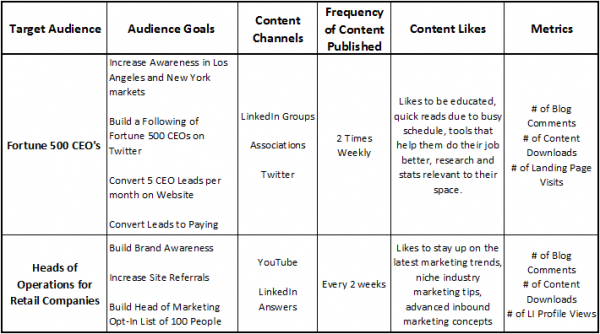Getting your content marketing strategy started means you need to clearly define your audience. Simply put, your content should connect with and be useful to your target audience. Do a simple exercise to identify your audience, so you have a clear direction for creating impactful content.
If your content doesn’t connect, it will be hard to engage your buyers, influencers, and advocates in a way that keeps them remembering you and following your content channels. When someone is interested in your content, they see it as a reliable source of useful information. When that person chooses to buy or recommend a company or product, you are already viewed as a trusted source.
- Step 1: List all the components to your company’s “ecosystem”. This includes customers, partners, suppliers, industry thought leaders, trade associations, peers, competitors, or anyone who can be considered part of your company’s value chain.
- Step 2: List 2-3 goals for each group of target audiences. This may be things like ‘Convert 5 CEO Leads on Our website each month” or “Be followed by at least 200 marketing executives per month on Twitter “.
- Step 3: List all of the channels that you plan to use for your content strategy. This includes Your Website, LinkedIn, Twitter, Facebook, 3rd party content aggregators, YouTube, RSS feeds, and Email.
- Step 4: List how frequently you plan to target each audience group with content. Weekly? Monthly? Quarterly?
- Step 5: List the content “likes” for your target audiences. Do they prefer email over social media? Does your audience want to be educated? Are they looking for “how-to” resources? Think about the nuggets of value they will acquire as a result of engaging with your content.
- Step 6: List the metrics you will monitor in reaching your audience goals. This may include things like “# of Twitter retweets and mentions”, “# of content downloads on website”, “# of site referrals from abc.com”, or “# of blog comments by CEOs”.
To help keep you organized, try creating a simple spreadsheet like the one below. It’s easy to get lost in the minutia with content marketing strategy. Keep it simple at first and keep the spreadsheet as a “living” document so you can fine tune your definitions as you analyze metrics and audience engagement.
At the very least, you should now have a clear idea of your target audiences, your goals for each group, how you will communicate to them, what they value, and how you will measure your success in engaging them. As you start to come up with titles and concepts for your content, look to your definitions to keep you centered on your audience and the business goals of content marketing.
Photo credit: Jonas B
